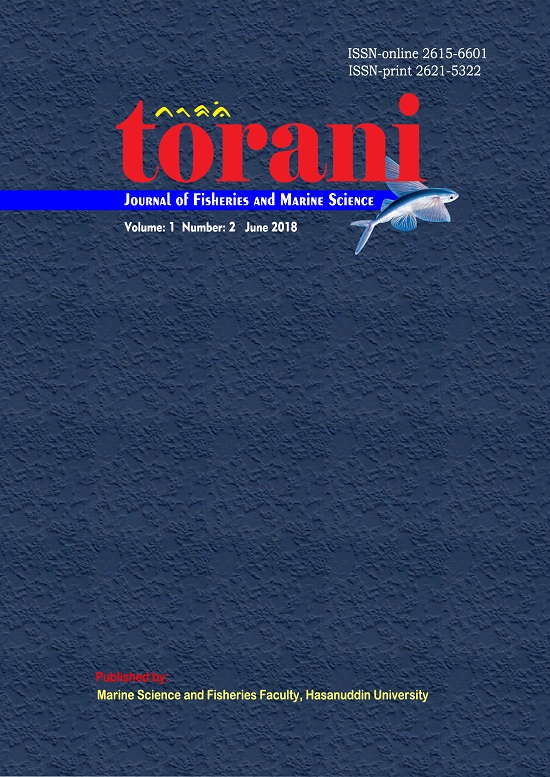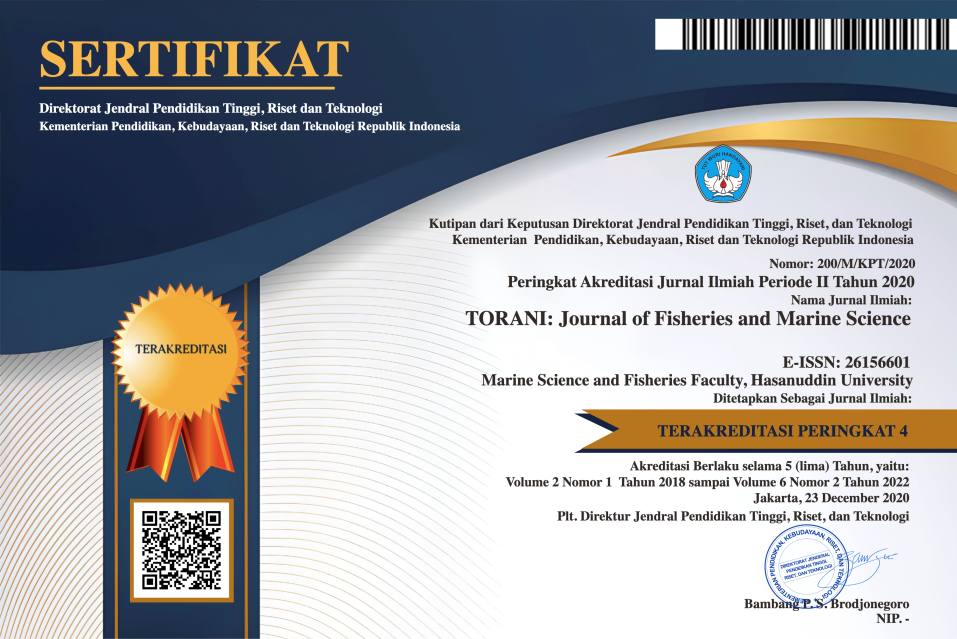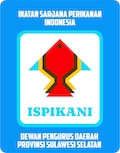The Concentration of Lead in Windowpane Oyster (Placuna placenta) and Potential of Condition Index as a Morphological Biomarker to Detect Metal Pollution
DOI:
https://doi.org/10.35911/torani.v1i2.4437Abstract
As a filter feeder, windowpane oyster, Placuna placenta, which lives as a sedentary animal is very appropriate to be used as an eco-sentinel organism in marine bio-monitoring campaign. The study of lead (Pb) content in the tissue and shell of P. placenta was conducted in coastal waters of Mandalle, Pangkajene Kepulauan District, South Sulawesi. A hundred of oysters were collected from coastal waters of Mandalle. Morphometry parameters which were length, high, width, and dry weight of tissue were measured in the laboratory. Those parameters were used for determination of Condition Index (CI). Metal was analyzed by Atomic Absorption Spectrometry. The results showed that the contents of Pb in tissue and shell were 0.021 and 0.014 mg/kg DW (dry weight) respectively. The concentration of Pb in tissue was not overreach by BPOM 2009 Number Hk.00.06.1.52.4011 of 1.5 mg / kg DW (dry weight). After calculating Maximum Tolerable Intake (MTI), we found that MTI was 7.79 kg/day. In terms of marine monitoring campaign, we can theoretically use the CI as a morphological biomarker. After calculating the relationship between Pb in tissue and shell, we found that the value of CI was not correlated significantly with Pb content in tissue and shell. However, the correlation coefficient between Pb in tissue and CI was stronger than that in the shell. The potential of CI of windowpane oyster as a morphological biomarker was discussed.Keywords: Placuna placenta, lead, MTI, morphological biomarkerDownloads
References
Achuthankutty, C. T., Nair, S. S., & Madhupratap, M. 1979. Pearls of the windowpane oyster, Placuna placenta. Mahasagar. 12(3), 187-189.
Badan Pengawas Obat dan Makanan Republik Indonesia, 2009, Peraturan Kepala Badan Pengawas Obat dan Makanan Republik Indonesia Nomor Hk,00,06,1,52,4011 tentang penetapan batas maksimum cemaran mikroba dan kimia dalam makanan,
C. K. Yap, A. Ismail, and S. G. Tan. 2003. Effects of Total Soft Tissue and Shell Thickness on the Accumulation of Heavy Metals (Cd, Cu, Pb, and Zn) in the Green-Lipped Mussel Perna viridis. Russian Journal of Marine Biology. 29:323–327.
Foster-Smith, R. L. 1975. The effect of concentration of suspension on the filtration rates and pseudofaecal production for Mytilus edulis L., Cerastoderma edule (L.) and Venerupis pullastra (Montagu). Journal of Experimental Marine Biology and Ecology. 17:1-22.
Gagné F., Burgeot T., Hellou J., St-Jean S., Farcy E., Blaise C., 2008. Spatial variations in biomarkers of Mytilus edulis mussels at four polluted regions spanning the Northern Hemisphere. Environmental Research 107: 201–217.
Gallardo, W. G., Siar, S. V., & Encena, V. 1995. Exploitation of the window-pane shell Placuna placenta in the Philippines. Biological conservation: 73: 33-38.
Galvao, P., Longo, R., Torres, J. P. M., & Malm, O. 2015. Estimating the potential production of the brown mussel Perna perna (Linnaeus, 1758) reared in Three Tropical Bays by different methods of condition indices. Journal of Marine Biology, 2015.
Gosling, E. 2003. Bivalve Molluscs: Biology, Ecology and Culture. Fishing News Books, Oxford. UK.
Hansen, P. D. 2008. Biosensors and Eco‐toxicology. Engineering in Life Sciences. 8: 26-31.
Ivankovic D., Pavicic J., Erk M., Filipovic-Marijic V, Raspor, B., 2005. Evaluation of the Mytilus galloprovincialis Lam. digestive gland metallothionein as a biomarker in a long-term field study: seasonal and spatial variability. Marine Pollution Bulletin 50: 1303–1313.
Kiorboe, T., & Mohlenberg, F. 1981. Particle selection in suspension-feeding bivalves. Marine. Ecology Progress Series.5:291-296.
Kljakovic-Gaspic Z., Herceg-Romanic S., Kozul D., Veza, J., 2010. Biomonitoring of organochlorine compounds and trace metals along the Eastern Adriatic coast (Croatia) using Mytilus galloprovincialis. Marine Pollution Bulletin 60:1879–1889.
Kooijman, S. A. L. M. 2006. Pseudo-faeces production in bivalves. Journal of Sea Research, 56:103-106.
Li, L., & Ortiz, C. 2013. Biological design for simultaneous optical transparency and mechanical robustness in the shell of Placuna placenta. Advanced Materials, 25:2344-2350.
Lobel, P.B., Bajdik ,C.D., Belkhode SP, Jackson SE, & Longerich HP. 1991. Improved protocol for collecting mussel watch specimens taking into account sex, size, condition, shell shape, and chronological age. Archives of Environmental Contamination and Toxicology. 21:409-414.
Löf, M., Sundelin, B., Liewenborg, B., Bandh, C., Broeg, K., Schatz, S., & Gorokhova, E. 2016. Biomarker-enhanced assessment of reproductive disorders in Monoporeia affinis exposed to contaminated sediment in the Baltic Sea. Ecological Indicators. 63:187-195.
Mamon, M. A. C., Añano, J. A. P., Abanador, L. C., Agcaoili, G. J. T., Sagum, C. B., Pagliawan, R. L. H., Tapere, J.M.B., Agravante, J.B.M., Arevalo J.H.G., Minalang., AJA.& Minalang, A. J. A. 2016. Pollutant exposure in Manila Bay: Effects on the allometry and histological structures of Perna viridis (Linn.). Asian Pacific Journal of Reproduction. Inpress
Mubiana, V. K., Vercauteren, K., & Blust, R. 2006. The influence of body size, condition index and tidal exposure on the variability in metal bioaccumulation in Mytilus edulis. Environmental Pollution, 144(1), 272-279.
Otter, R. R., McKinney, D., Brown, B., Lainer, S., Monroe, W., Hubbs, D., & Read, B. 2015. Bioaccumulation of metals in three freshwater mussel species exposed in situ during and after dredging at a coal ash spill site (Tennessee Valley Authority Kingston Fossil Plant). Environmental Monitoring and Assessment. 187:1-14.
Shumway, S. E., Cucci, T. L., Newell, R. C., & Yentsch, C. M. 1985. Particle selection, ingestion, and absorption in filter-feeding bivalves. Journal of experimental marine biology and ecology, 91(1), 77-92.
Simbolon, AR., Riani, E., Wardiatno, Y. 2014. Status pencemaran dan kandungan logam berat pada simping (Placuna placenta) di Pesisir Kabupaten Tangerang. Depik. 3: 91-98.
Stambuk A., Srut M., Satovic Z., Tkalec M., Klobucar GIV. 2013. Gene flow vs. pollution pressure: Genetic diversity of Mytilus galloprovincialis in eastern Adriatic. Aquatic Toxicology. 136 : 22-31.
Yap, C. K., & Al-Barwani, S. M. 2012. A comparative study of condition indices and heavy metals in Perna viridis populations at Sebatu and Muar, Peninsular Malaysia. Sains Malaysiana.41: 1063-1069.
Yap, C. K., & Tan, S. G. 2011. A study on the potential of the periostracum of Perna viridis as a biomonitoring material for Pb in tropical coastal waters based on correlation analysis. Sains Malaysiana, 40(8), 809-819.
Yaqin, K., Lay B.W., Riani E., Masud, Z.A., & Hansen, P.D. 2011. Hot spot biomonitoring of marine pollution effects using cholinergic and immunity biomarkers of tropical green mussel (Perna viridis) of the Indonesian waters. Journal of Toxicology and Environmental Health Sciences. 3: 356–366
Yaqin K. 2010 Potential use of cholinesterase activity from tropical green mussel, Perna viridisas a biomarker in effect-based marine monitoring in Indonesia. Coastal Marine Science 34: 156–16
Yaqin, K., Fachruddin, L., Rahim, N.F. 2015. Studi Kandungan Logam Timbal (Pb) Kerang Hijau,Perna Viridis Terhadap Indeks Kondisinya. Jurnal Lingkungan Indonesia. 3: 309- 317
Yaqin, K., Nursyamsiah, Umar, MT, Fachruddin, L, dan Bachtiar, B. 2014. Apakah variasi ukuran panjang cangkang memengaruhi konsentrasi logam timbal di dalam daging kerang hijau, Perna viridis? Prosiding Simposium Nasional I Kelatan dan Perikan. Fakultas Ilmu Kelautandan Perikanan, Universitas Hasanuddin Makasssar.
Yaqin, K., & Hansen, P. D. 2010. The use of cholinergic bio-marker, cholinesterase activity of blue mussel Mytilus edulis to detect the effects of organophosphorous pesticides. African Journal of Biochemistry Research. 4: 265–272.



















